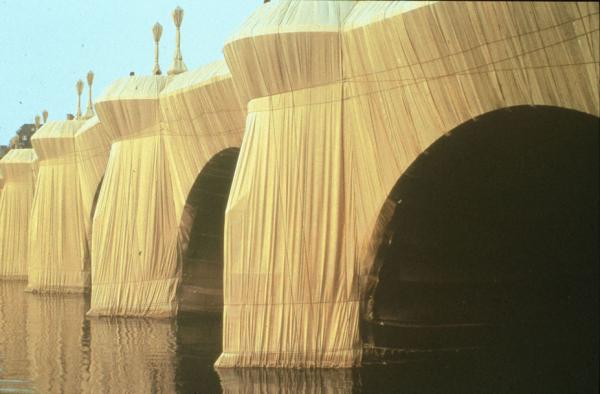Christo Gallery
The sides and vaults of the twelve arches, without hindering river traffic.
The parapets down to the ground.
The sidewalks and curbs (pedestrians walked on the fabric)
All the street lamps on both sides of the bridge.
The vertical part of the embankment of the western tip of the Ile de la Cité.
The esplanade of the "Vert-Galant".
The fabric was restrained by 13,076 meters (42,900 feet) of rope and secured by 12.1 metric tons (11.8 long tons) of steel chains encircling the base of each tower, 1 meter (3.3 feet ) underwater.
The "Charpentiers de Paris" headed by Gérard Moulin, with French sub-contractors, were assisted by the USA engineers who have worked on Christo and Jeanne-Claude's previous projects, under the direction of Theodore Dougherty: Vahé Aprahamian, August L. Huber, James Fuller, John Thomson and Dimiter Zagoroff.
Johannes Schaub, the project's director had submitted the work method and detailed plans and received approval for the project from the authorities of the City of Paris, the Departement of the Seine and the State.
600 monitors, in crews of 40, lead by Simon Chaput, were working around the clock maintaining the project and giving information, until the removal of the project on October 7.
All expenses for The Pont Neuf Wrapped were borne by the artists as in their other projects through the sale of preparatory drawings and collages as well as earlier works.
Begun under Henri III, the Pont-Neuf was completed in July 1606, during the reign of Henry IV. No other bridge in Paris offers such topographical and visual variety, today as in the past. From 1578 to 1890, the Pont Neuf underwent continual changes and additions of the most extravagant sort, such as the construction of shops on the bridge under Soufflot, the building, demolition, rebuilding and once again demolition of the massive rococco structure which housed the Samaritaine's water pump. Wrapping the Pont-Neuf continues this tradition of successive metamorphoses by a new sculptural dimension and transforms it, for fourteen days, into a work of art .
Ropes held down the fabric to the bridge's surface and maintained the principal shapes, accentuating relief while emphasizing proportions and details of the Pont-Neuf which joins the left and right banks and the Ile de la Cité, the heart of Paris for over two thousand years.

viewer |
|
|
| Reichstag Wrapped |
| Running Fence |
| Valley Curtain |
Pont Neuf Wrapped |
| Wrapped Coast |
| Surrounded Islands |
| Umbrellas |
Biography
Bulletin Board
Renowned Art
(home)
Christo was born in Gabrovo, Bulgaria. He studied at the Fine Arts Academy in Sofia from 1953 to 1956, when he moved to Prague. In 1957 Christo escaped to Vienna where he lived briefly before moving to Paris. Christo began his wrapped objects in Paris in 1958.
all artists, with thumbnails: by birth year | alphabetically
all artists: by birth year | alphabetically
artists born in the 13th 14th 15th 16th 17th 18th 19th 20th century